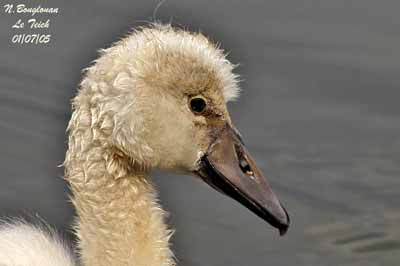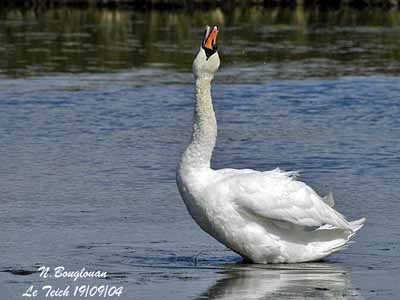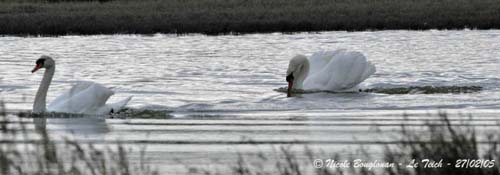
Fr: Cygne tuberculé
All : Höckerschwan
Esp : Cisne Vulgar
Ital : Cigno reale
Nd : Knobbel zwaan
Russe : Лебедь-шипун
Sd : Knölsvan
Photographers :
Eugène Montocchio
Galerie Photos Nature
Jean Michel Peers
JMPN PHOTOGRAPHIE
Nicole Bouglouan
PHOTOGRAPHIC RAMBLE
Texte de Nicole Bouglouan
Sources :
HANDBOOK OF THE BIRDS OF THE WORLD vol 1 by Josep del Hoyo-Andrew Elliot-Jordi Sargatal - Lynx Edicions - ISBN: 8487334105
THE HANDBOOK OF BIRD IDENTIFICATION FOR EUROPE AND THE WESTERN PALEARCTIC by Mark Beaman, Steve Madge - C.Helm - ISBN: 0713639601
THE COMPLETE BOOK OF BRITISH BIRDS – Written by “Royal Society for the Protection of Birds” experts - Préface de Magnus Magnusson - Michael Cady- Rob Hume Editors - ISBN: 0749509112
L’ENCYCLOPEDIE MONDIALE DES OISEAUX - Dr Christopher M. Perrins - BORDAS - ISBN: 2040185607
GUIDE DES CANARDS, DES OIES ET DES CYGNES – de Steve Madge - Delachaux et Niestlé - ISBN: 2603013769
Mute Swan
Cygnus olor
Anseriforme Order – Anatidae Family
BIOMETRICS:
Length: 125-160 cm
Wingspan: 240 cm
Weight: 6-15 kg
DESCRIPTION:
The Mute Swan is an integral part of our urban parks and of most of the waters in our regions. But this beautiful white bird is originally a wild animal, with not always compatible behaviour and habits with the life in city parks.
When the breeding season starts, the male becomes aggressive because it defends its family. We have to be careful and to make a detour if we find a nest close to the path.

Adults are white overall. We can see sometimes a brownish wash on crown, cheeks and neck.
Male has prominent black knob on the upper base of the bill which is orange with black nail. Eyes are dark brown with black lores. The short, strong legs and the webbed feet are black.
Female has similar plumage and appearance, but she is slightly smaller than male. She has smaller knob on bill.
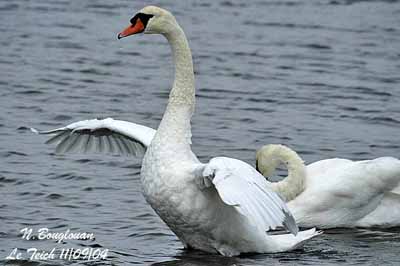

Juveniles have greyish-brown plumage, turning white into the first winter, but some feathers may be grey until the second winter. Legs are black, bill is grey and eyes are brown.
Nestlings are pale grey with white underparts. Bill is dark blue-grey and legs are blue-grey. Nestlings in pale morph are white with pale grey-pink legs.
The Mute Swan has keen sight and hearing.
In wild, it may live about 20 years, but much more in captivity, up to 30-40 years.
VOICE: SOUNDS BY XENO-CANTO
The Mute Swan is usually silent. Adults may sometimes produce noisy hisses or whistles, or utter some yelps as those of young dogs. These sounds are not far-carrying due to the straight trachea.
The sounds produced by the wing-beats during the flight are similar to humming or musical buzzing. It is very audible.
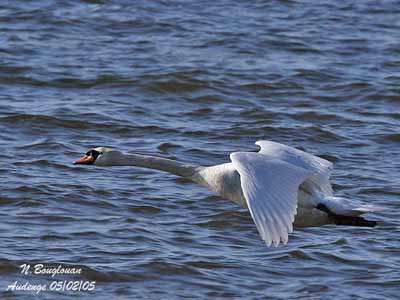
HABITAT:
The Mute Swan needs a large territory including small lake or pond. During winter, it is common in sheltered bays, open marshes, lakes, ponds, streams, estuaries and coastal areas.
The species has adapted to the life close to human, and this bird may be common in artificial water bodies such as lakes in parks, reservoirs, private ponds…
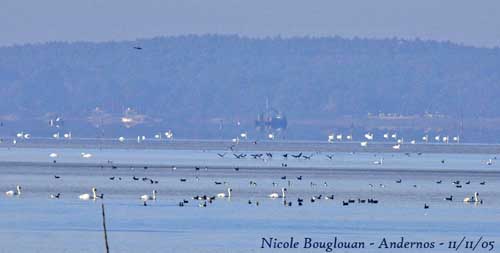
RANGE:
The Mute Swan breeds in British Islands, N and C Europe and N and C Asia.
During winter, it reaches North Africa, the Near East and Korea.
It has been introduced successfully in North America where it is now resident.
Feral populations are established in Japan, South Africa, SW Australia and New Zealand.
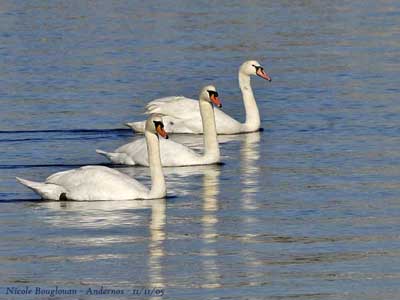
BEHAVIOUR:
The Mute Swan feeds by day, by dabbling on water surface and upending. It plunges the head with stretched neck into deeper waters, about more than 45 cm depth, in order to reach the aquatic vegetation at the bottom. The juveniles are fed by parents with cut vegetation.
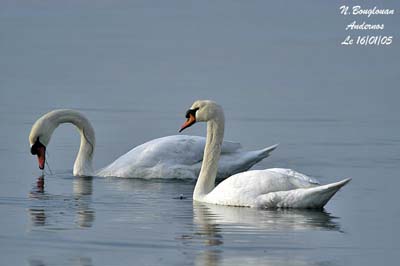
It uses conspicuous signs and postures to communicate. During the nesting period, the male is highly territorial and aggressive. As soon as an intruder approaches the nest, animal or human, it adopts a typical attitude, coming fast over water, with neck and head backwards, forming and arch ready to attack.
The secondaries also form an arch towards the back. It may give slaps with the wings, the leading edge being very strong.
The male tends to defend the whole territory, using mainly neck and wings to drive away the intruders. They perform bowing, wing-flapping and head-jerking, with fluffed feathers, accompanied by loud calls.
Such fights may be strong and violent, involving the use of the bill and the bend of the wing. One bird may die and sometimes both opponents.
The young cygnets in pale morph are sometimes attacked by their parents.
However, non-breeding adults and immatures are gregarious all year round. If a nest-failure occurs, the pair leaves the territory and joins other groups for moulting.
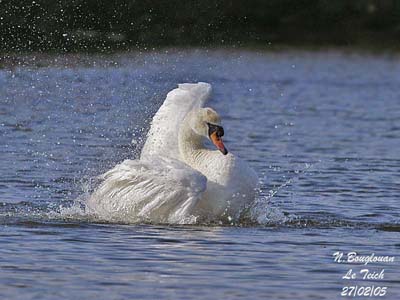
When swimming, the Mute Swan makes a graceful arch with the neck, bill pointed downwards, whereas other swans and geese keep raised neck and bill.
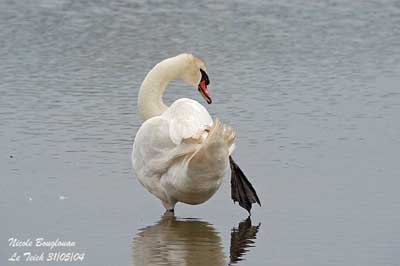
The swans living in cold areas migrate southwards for wintering. The sedentary birds remain on breeding areas or join other wintering flocks. Sometimes, they move to moult.
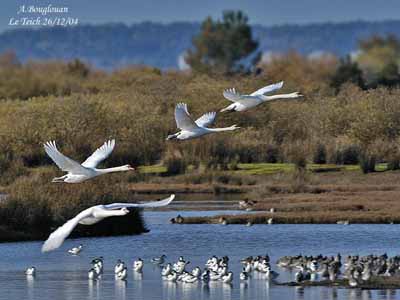
FLIGHT:
The Mute Swan performs a lengthy run along the water to take off. At the same time, it performs powerful wing-beats and takes flight. Wings are very strong, with large and well developed wing muscles.
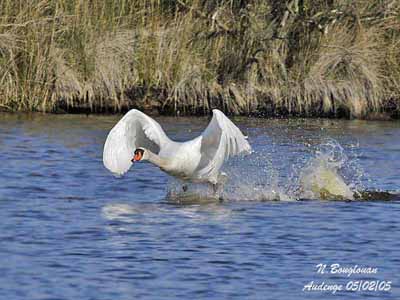
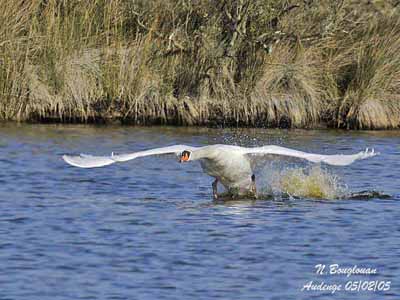
Once in flight, it maintains fast rate of wing-beats. It does not soar, but it tends to glide before to land. It alights on water, coming down with lowered feet and fully spread webs to reduce the speed before the contact with the body.
During migrations, the Mute Swan may reaches speeds of 85-88 km per hour.
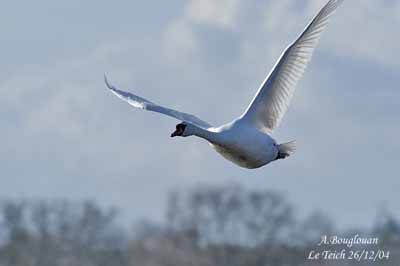
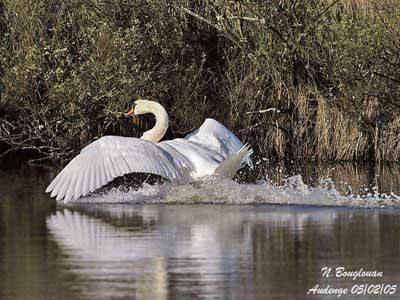
REPRODUCTION:
Pair-bonds are not for life in Mute Swans. The male may have four mates, or even to divorce for other female. They remain together during at least for one season.
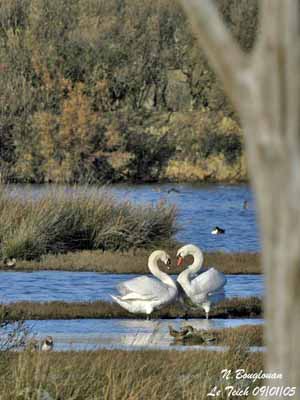
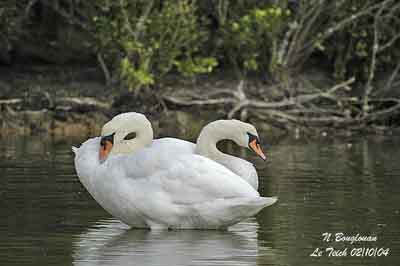
The Mute Swan breeds during the local spring according to the range.
Nest is built by both parents. Male brings nest materials to the female. It is a large mound of vegetation among the reeds or floating on water.
She lays 5-12 pale grey, green or blue-green eggs of about 340 grams each. Incubation lasts about 36-38 days, mainly by female while male defends the territory. It takes some turns when she is feeding, and incubates if she disappears.
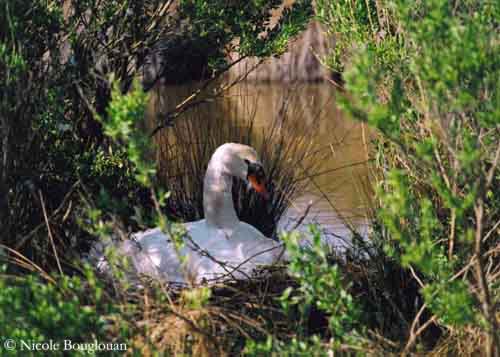
Chicks hatch over 26 hours. Both parents tend the young. Female broods them, and the cygnets often ride on female’s back at 10 days old.
They are fully feathered two months after hatching. They reach their sexual maturity at three years. They remain with parents until the next spring and breeding season.
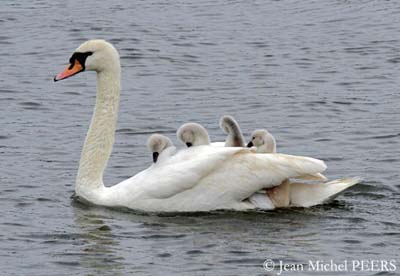
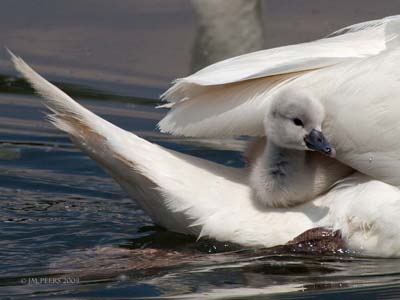
DIET:
The Mute Swan feeds primarily on the leafy parts of aquatic vegetation and grain. It also consumes grasses, small amphibians, molluscs, worms and insects.
It catches them with the bill, and filters the mud thanks to the lamellae on the sides of the mandibles.
It may be seen foraging in wet meadows and grassy areas.
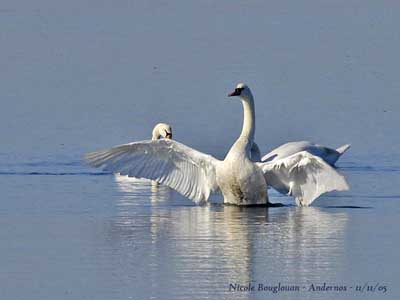
PROTECTION / THREATS / STATUS:
The Mute Swan is threatened by lead poisoning in lakes and ponds.
However, populations ate stable and this species breeds well in captivity or semi-captivity. Their range is increasing, due to the establishment of feral populations with introduced bird for ornamental purposes in cities and urban parks.
